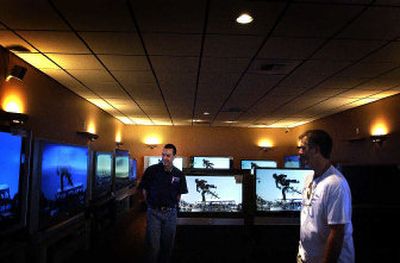Mixed signals

Mike Harrison works in the electronics section of the Costco Wholesale store in Coeur d’Alene, where daily he finds people working their way through the digital-TV maze.
People in general know something is about to change with regard to television technology. But most have no clue what the change will be, said Harrison.
“A lot of people come in and think they have to buy a high-definition TV within the next two years. They don’t,” Harrison said. “Then there are a lot of people who are conservative and don’t want to buy anything, because they’re uncertain what’s going to happen.”
That uncertainty comes from repeated changes in the official plan to move all over-the-air television signals from their current analog form to an all-digital broadcast.
Earlier plans endorsed by Congress and the Federal Communications Commission had set a switch date in 2007. But that date had a built-in escape clause, which led to further talks to find a new transition date.
Two bills now before Congress have proposed a final date to switch to digital TV broadcasts of Jan. 1, 2009.
Observers say they expect one of those bills to be passed and signed into law by December.
Harrison admitted he hadn’t heard about the proposed change in dates. “We went to Spokane for a training a year and a half ago. They told us at that point that it would be 2007,” he said.
Retailers in this area say most electronics consumers vaguely know the broadcast technology is changing, but buyers are uncertain what action they should take. The uncertainty means retailers aren’t selling as many of the newer, digital TV sets as they had hoped.
The digital-TV dilemma has prodded retailers, politicians, broadcasters and manufacturers to rally behind the idea of a fixed date, something they couldn’t agree on earlier, said Megan Pollock, a communications manager for the Consumer Electronics Association, based in Washington, D.C.
“Everyone agrees that we’ll all be better off with a certain date,” she said. “It will be very good for consumers,” and it will help industry groups who need to prepare for the all-digital switch, she said.
When the change does occur, the major impact will be felt by roughly 21 million U.S. households that don’t subscribe to cable or satellite TV services. That 12 percent portion of the U.S. TV audience would wake up after the big switch seeing static on their screens.
Those homes that are non-digital — and who don’t want to spend big bucks to replace their TV sets — will have the option of buying converter boxes for their analog sets.
The box, expected to cost between $50 and $80, would take over-the-air digital signals and convert them to analog signals.
Still, many consumers in Spokane and North Idaho continue to walk into retail stores and think they have to spend several hundred more dollars on a digital TV in order to watch programs once the switch takes place.
TV manufacturers are making the gradual switch to the all-digital world. Last year, U.S. consumers bought about 20 million analog TV sets and 7.3 million digital TV sets. Digital sets come in three types, with high definition (HDTV) producing the best visual quality and often costing the most.
“This year, for the first time, we are predicting more digital TV sets sold (in the United States) than analog sets,” said Pollock.
Spokane Valley resident Josh Taylor, who’s 30, says he’d love to buy a high-definition TV set soon. While shopping at the Spokane Valley Best Buy store, Taylor said he vaguely understands that he has three choices: buying a basic analog set, buying a higher-priced HDTV set, or something in between, usually referred to as DTV — an integrated set that has a tuner capable of capturing both analog and digital signals.
Taylor and his wife have three TV sets at home, all of them over-the-air analog models.
“It’s pretty confusing. I don’t want to spend too much money. I just want to watch some movies and have something for DVDs that I want to see,” he said.
Adding to the confusion are different kinds of HDTVs being sold. Some come with built-in digital tuners. But other models are listed as “HDTV-ready” or “HD-upgradeable,” meaning the monitor can display high-definition programs, but a tuner must be added separately.
Despite the maze of products, some retailers say many consumers know about HDTV and are buying HDTV sets, which start at about $600.
“The biggest upgrade choice we see is from analog up to high-def,” said Scott Rehn, home electronics manager for Huppin’s Hi-Fi, Video and Photo in downtown Spokane.
The interest has little to do with changes in broadcast regulations, Rehn added. Rather, it’s the allure of higher-quality video with resolution that’s far better than traditional analog TV, he said.
“Once people have seen HDTV, they get excited. It’s a mind-blower,” said Rehn.